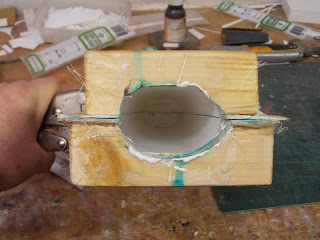GRP is straight forward to work with however it has few drawbacks ;
1) polyester resin has a very strong smell, not the most house friendly smell ( my father made GRP moulds in the house when I was a child) unless your wife is very understanding. very much like car body filler (bondo) which is often polyester resin based.
2) when you trim or sand it you NEED to wear a mask, don't rub your skin or face with the dust or you will itch like heck !
3) if it starts to cure and if your not done your part can be ruined.
Apart from a childhood introduction into GRP, my father making parts in the next bedroom, I used to make GRP truck cabs for Foden as well as parts for Rolls Royce motor cars so I have quite a lot of experience in using GRP and mould making.
As I mentioned earlier I use polyester resin, there are several different grades. General purpose laminating resin is more than adequate for this use. The resin is cured via a catalyst which can come in a liquid or paste form the paste is not unlike the catalyst for car body filler. One word of warning, the liquid catalyst is an organic peroxide it will can cause very severe eye damage so wear safety glasses and gloves when using it.
As for the fibreglass itself it comes in a woven cloth and chopped strand mat (CSM) the latter is made up of short lengths of glass fibres in a random pattern held together by a powdered emulsion. When resin is applied the emulsion is dissolved and the fibres can be formed into position.
To clean tools and brushes you need acetone, which will dissolve un cured resin by will not shift it once cured. I have a plastic tub with a sealable lid in which I pour a quantity of acetone and use it for cleaning and storing my tools.
As I mentioned above there are a few things to bear in mind when using GRP, but its a process that can help make and replicate shapes that may have been very difficult by other methods.
To make a MACK
I carved a MACK from a lump of balsa, I then covered it a thing layer of fibre glass matting, then surface tissue ( a very thin cloth) to give it a smooth surface for sanding and polishing. this is the master or plug.
To stop the resin sticking to the plug it is given several coats of mould release wax and then a PVA release agent. The mould will need to be in two parts so the plug is let into section of plywood that has itself been waxed and had PVA applied. The gap between the plug and the ply wood is filled with plasticene, the blue blobs on the plywood are plasticene. they are there to help align the moulds later on.
It pays to get the surface of the plug as smooth as possible, the surface of the plug will be replicated in the mould and any subsequent parts you make.
The plug and ply wood is covered in another type of resin 'gel coat' this is thicker than normal resin and remains tacky after its initial cure to receive the resin and fibreglass cloth/matting this gives a good and hard wearing finish to the mould surface
Once tacky the mould half is laid up in resin and glass matting. I put three layers on over the plug then used wood to stop any warps in the mould over time. The wooden blocks on the ends are for keeping the mould steady when laying up the inside.
The procedure for the other half is the same as above, now the edges are trimmed and the two halves are separated. Without any release agent the wooden plug would now be entombed in the fibre glass.
The PVA release agent is cleaned off with hot water, before you can make a MACK you need to wax and PVA the mould's halves again.
Now you the two halves, once waxed etc, gel coat is applied to the depression in the mould only they two halves are laid up the matting being left a few mm short of the top . when cured they are clamped together. You have a very small aperture through which you need to lay GRP to join the two halves. This can be tricky I used a long strips of cloth to cover the gap between the two halves. I don't have any images of laying up, next time I lay up GRP I will take some and add them for clarity.
Once cured the mould is popped open after a trim and sand you get a light weight and robust and
structure.







No comments:
Post a Comment